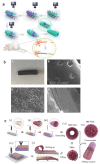A Comprehensive Review on Bioprinted Graphene-Based Material (GBM)-Enhanced Scaffolds for Nerve Guidance Conduits
- PMID: 40277612
- PMCID: PMC12024949
- DOI: 10.3390/biomimetics10040213
A Comprehensive Review on Bioprinted Graphene-Based Material (GBM)-Enhanced Scaffolds for Nerve Guidance Conduits
Abstract
Peripheral nerve injuries (PNIs) pose significant challenges to recovery, often resulting in impaired function and quality of life. To address these challenges, nerve guidance conduits (NGCs) are being developed as effective strategies to promote nerve regeneration by providing a supportive framework that guides axonal growth and facilitates reconnection of severed nerves. Among the materials being explored, graphene-based materials (GBMs) have emerged as promising candidates due to their unique properties. Their unique properties-such as high mechanical strength, excellent electrical conductivity, and favorable biocompatibility-make them ideal for applications in nerve repair. The integration of 3D printing technologies further enhances the development of GBM-based NGCs, enabling the creation of scaffolds with complex architectures and precise topographical cues that closely mimic the natural neural environment. This customization significantly increases the potential for successful nerve repair. This review offers a comprehensive overview of properties of GBMs, the principles of 3D printing, and key design strategies for 3D-printed NGCs. Additionally, it discusses future perspectives and research directions that could advance the application of 3D-printed GBMs in nerve regeneration therapies.
Keywords: 3D printing; graphene-based materials; nerve guidance conduits; tissue engineering.
Conflict of interest statement
The authors declare no conflicts of interest.
Figures










Similar articles
-
Additive manufacturing of peripheral nerve conduits - Fabrication methods, design considerations and clinical challenges.SLAS Technol. 2023 Jun;28(3):102-126. doi: 10.1016/j.slast.2023.03.006. Epub 2023 Apr 5. SLAS Technol. 2023. PMID: 37028493 Review.
-
3D printing of functional nerve guide conduits.Burns Trauma. 2021 May 7;9:tkab011. doi: 10.1093/burnst/tkab011. eCollection 2021. Burns Trauma. 2021. PMID: 34212061 Free PMC article. Review.
-
Bridging the gap in peripheral nerve repair with 3D printed and bioprinted conduits.Biomaterials. 2018 Dec;186:44-63. doi: 10.1016/j.biomaterials.2018.09.010. Epub 2018 Sep 12. Biomaterials. 2018. PMID: 30278345 Review.
-
Nerve guide conduits promote nerve regeneration under a combination of electrical stimulation and RSCs combined with stem cell differentiation.J Mater Chem B. 2024 Nov 20;12(45):11636-11647. doi: 10.1039/d4tb01374c. J Mater Chem B. 2024. PMID: 39404058
-
3D Printed Personalized Nerve Guide Conduits for Precision Repair of Peripheral Nerve Defects.Adv Sci (Weinh). 2022 Apr;9(12):e2103875. doi: 10.1002/advs.202103875. Epub 2022 Feb 18. Adv Sci (Weinh). 2022. PMID: 35182046 Free PMC article. Review.
References
-
- Sachanandani N.F., Pothula A., Tung T.H. Nerve gaps. Plast. Reconstr. Surg. 2014;133:313–319. - PubMed
-
- Guarino V., Cirillo V., Ambrosio L. 6.18 Multicomponent Conduits for Peripheral Nerve Regeneration. Elsevier; Amsterdam, The Netherlands: 2017.
-
- Jansen K., Van Der Werff J., Van Wachem P., Nicolai J.A., De Leij L., Van Luyn M.J.B. A hyaluronan-based nerve guide: In vitro cytotoxicity, subcutaneous tissue reactions, and degradation in the rat. Biomaterials. 2004;25:483–489. - PubMed
-
- Wang S., Wan A.C., Xu X., Gao S., Mao H.-Q., Leong K.W., Yu H.J.B. A new nerve guide conduit material composed of a biodegradable poly (phosphoester) Biomaterials. 2001;22:1157–1169. - PubMed
Publication types
LinkOut - more resources
Full Text Sources

